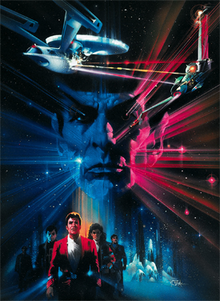Star Trek III: The Search For Spock
| Star Trek III: The Search for Spock |
|
|---|---|

Theatrical poster art by Bob Peak
|
|
| Directed by | Leonard Nimoy |
| Produced by | Harve Bennett |
| Written by | Harve Bennett |
| Based on |
Star Trek by Gene Roddenberry |
| Starring | |
| Music by | James Horner |
| Cinematography | Charles Correll |
| Edited by | Robert F. Shugrue |
| Distributed by | Paramount Pictures |
|
Release date
|
|
|
Running time
|
105 minutes |
| Country | United States |
| Language | English |
| Budget | $16 million |
| Box office | $87 million |
Star Trek III: The Search for Spock is a 1984 American science fiction film released by Paramount Pictures. The film is the third feature film of the Star Trek science fiction franchise and is the center of a three-film story arc that begins with Star Trek II: The Wrath of Khan and concludes with Star Trek IV: The Voyage Home. After the death of Spock (Leonard Nimoy), the crew of the USS Enterprise returns to Earth. When James T. Kirk (William Shatner) learns that Spock's spirit, or katra, is held in the mind of Dr. Leonard "Bones" McCoy (DeForest Kelley), Kirk and company steal the Enterprise to return Spock's body to his home planet. The crew must also contend with hostile Klingons, led by Kruge (Christopher Lloyd), bent on stealing the secrets of a powerful terraforming device.
Paramount commissioned the film after positive critical and commercial reaction to The Wrath of Khan. Nimoy directed, the first Star Trek cast member to do so. Producer Harve Bennett wrote the script starting from the end and working back, and intended the destruction of the Enterprise to be a shocking development. Bennett and Nimoy collaborated with effects house Industrial Light & Magic (ILM) to develop storyboards and new ship designs; ILM also handled the film's many special effects sequences. Aside from a single day of location shooting, all of the film's scenes were shot on Paramount and ILM soundstages. Composer James Horner returned to expand his themes from the previous film.
...
Wikipedia
